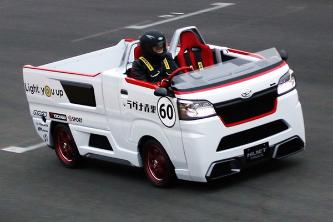awesome rotary engine
Artikel Terkait awesome rotary engine

Goldmine: Live the rotary dream with this Mazda RX7 FD3S
But hey, you dont become the only carmaker in the world to win the 24 Hours of Le Mans with a rotary
Watch: Proton Exora driver’s awesome, but wrongly used, lane change skill
Bermaz is considering a hybrid Mazda MX-30 for Malaysia, rotary-powered?
engine.
Mazda quietly released a new rotary engine when nobody was paying attention
Felix Wankel’s rotary engine design.
All-new 2022 Mazda 2 to start Thailand production in Q2 2022, to come with hybrid option
reveal that the fourth-generation model will have a hybrid option alongside a regular small displacement engine
Homemade drifting Perodua Kancil shows the best of muhibbah in the Malaysian car community
Somewhere in the veins of awesome Malaysian creations is this drifting Perodua Kancil.
Mazda's new 6-cylinder, RWD model will be a 3.0L SUV, coming 2023
Mazdas next SUV model will come packing rear-wheel-drive (RWD) and a 3.0-litre straight-six engine.
This Malaysian dad built his sons a VW Kombi bus bunk bed. It’s now on sale
Malaysian dad took the phrase “start them young” literally when he decided to build this awesome
The MG RX8 is a Toyota Fortuner rival that is NOT rotary-powered
alternative to the Land Cruiser.Powering the RX8 is, unfortunately for all you geeks out there, not a rotary
Geely celebrates Chinese New Year with a Guinness World Record-breaking car mosaic
The word “ox/ cow/ bull” in Chinese is also slang for “awesome” or “cool
Awesome Lego set demonstrates how CVTs work
video.This Lego CVT model allows us to see how the pulley systems on both ends expand and contract as the engine
Mazda confirms plug-in hybrid model by 2022. Rotary engine to return with electrification
Mazda’s CEO Akira Marumoto has confirmed that the company’s signature rotary engine will
Goldmine: Luxuriate like a Japanese executive in this rare 1990 Mazda Luce
Ah, 1980s Japan, where the Bubble Era is thriving and some funky, awesome music genre filled bars and
McLaren designer says the world needs more red Mazdas, pens this
Long bonnet, front-engine sports car with presumably a rotary engine.Typical of design concepts, the
Will the 2021 Honda HR-V be using a new rotary knob gear selector?
The gear selector is not of a conventional gear shifter but rather a rotary dial set-up.This gear selector
Let's take a look at Mazda’s electrified rotary engine, launching in 2022
What you see here, is a photo of Mazda’s upcoming rotary engine, mentioned alongside Mazda&rsquo
The Mazda Parkway was Mazda’s own vision for a rotary-powered RX-Bus
engine that powered the Mazda RX-7 and RX-8 sports cars, Mazda developed the engine for various models
Mild-hybrid Mazda MX-30 confirmed for Japan - new e-SkyActiv-G engine
A small capacity rotary-type range extender engine was also speculated to complement the electric-only
Italian style, Korean chassis, built in Malaysia, meet the Fauxrrari F430
of all time, nor is it even the greatest Ferrari of the 2000s but spotting one on the road is pretty awesome
All-new 2021 Mazda 2: Sept debut, new SkyActiv-X engine, rotary REEV in 2022?
on to say that the next-gen Mazda 2 could be fitted with a range extender electric powertrain with a rotary
Review Post awesome rotary engine
Mazda RX-7, the sound of the 20B Rotary Engine is awesome Video: http://t.co/xrdf1hTYAN http://t.co/XSAvvf0nqt
You have to see this Rotary Engine Move in Slow Motion https://t.co/RaMNbxILLo
This RX7 FC arrived at the meet. Not the prettiest on the lot but the rotary engine is awesome. #bltjmc305 https://t.co/RWNYzuqjtq
Awesome rotary engine in a kart! 60 bhp!!! http://t.co/LEcy52ib
80s Aussie rally memories: Barry Lowe's Dazda. Datsun 510 with a 280hp Mazda rotary engine. Awesome to drive on dirt. http://t.co/E39TwWVy
Cycloid Curve (type:2, R=2, r=1, d=0.5) from ExtraObject addon #b3d . #Blender is awesome. Seems like rotary engine almost done, right? 🤪 🤘 https://t.co/lThbtuY5Ta
@wtspman “Wankle Rotary Engine” nudge, nudge, wink, wink... I still think the big aviation rotaries are awesome! @CWHM https://t.co/9FWbP6mPIV
All of the awesome. Mazda brings back rotary engine returns in new concept coupe: https://t.co/cXqtszSvX9 https://t.co/CAOCZiMwBG
interesting RT @TheRealMA: Word on street is that #Mazda's RX9 will develop 300 HP from a new rotary engine. http://bit.ly/cLt3y4 #Awesome
Rotary #engine #rotoryengine Awesome video
Review Q&A awesome rotary engine
Is the Mazda rotary engine more fuel efficient than a cylinder engine?
There's a bit more to it than that. These engines are also normally designed to produce power/torque at high RPMs - but there's potential in using longer intake runners to add low RPM torque, and so better mileage around town. The awesome Mazda Le Mans 26B engine used a variable intake tract to tune the resonance of the intake tract at varying RPM to provide a charging effect. While they may not be more fuel efficient in current road vehicles - they produce more power from the same combustion chamber size, are lighter, and less complex than piston engines. A more equivalent test would be the RX8 against a 1.3l four stroke engine producing equivalent power. There really isn't one - the only thing that would come close would be a turbocharged Hayabusa engine. That's unlikely to make good fuel mileage. Even then, the later versions of the RX8 made 240hp - and would long outlast any highly stressed 1.3 four stroke. I'm not a fan boy - I just think that the apparent inefficiency of the Wankel rotary is mostly a matter of perspective.
Can cylinders of an engine take any other besides the traditional round shape?
1979 Honda NR500 The NR500 was Hondas attempt to answer the awesome power output of 2-stroke GP motorcycle engines in the late 1970’s The oval-pistoned V4 four-stroke NR500 was developed, with eight valves and two con-rods per cylinder and an insane rev ceiling of nearly 20,000 rpm An NR500 piston with its two con-rods, 8 valves and dual spark plugs NR500 GP bike Sadly, while it it quite easy to machine circular pistons, piston rings and cylinders - the technology needed to produce oval cylinders, and seal the combustion gases using oval piston rings was very expensive, and not a 100% success. The added complexity in building and maintaining these engines did not pay off - especially when compared to the simplicity and mechanical efficiency of the traditional ported 2-stroke engine The Wankel rotary engine also uses a sort of oval cylinder space - actual a closely coupled double circular area - as these pictures show, and uses a basically triangular rotor in place of a piston to achieve intake (suction), compression, then exhaust cycles - which is apparently still a 4 stroke, (or 4 phase, rather than 4 “stroke” - there is no “up, down, up down” motion) ,system as opposed to a 2-stroke or 4-stroke traditional piston engine - no con-rods, very little reciprocating mass (Thanks to ,Steve Meyer, for providing the animated gif in the comments below this answer) Wankel rotor showing the rotor positions for intake, compression and exhaust cycles. Norton NRV588 cc Wankel engined race bike Norton JPS specials showing off Other odd shapes, such as square could be attempted, but would not provide any benefit, and would bring even more engineering headaches than the Honda oval system - which was adopted as a way to increase the valve area above the piston to increase combustible volume without using a compressor (such as a turbo, or supercharger system - not permitted in motorcycle GP engines)
Which cars won’t even last 100,000 Miles?
Hi! Generally, any well-maintained car will last for at least 100 k miles. I had a Mazda RX-8 (Rotary Engine) made it to a 110 k miles..even though the design of the Rotary engine is in itself flawed..man that car used up a lot of oil and had terrible gas mileage..but it was fun to drive and looked awesome! Have a lovely day! Ale
Why hasn't Mazda tried to built a electric car like Tesla or Chevy Bolt EV?
Mazda is a great car company building some awesome driver focused cars for quite sometime. But they are a very small car company with limited R&D budget. Which means they can't invest heavily into the EV space right away like Tesla or Toyota or BMW. Design and Development is an extremely expensive procedure for any auto manufacturer and it is one of the reasons why we see similar design theme across all car manufacturers with vehicle architecture being shared between atleast 4 body styles. Coming back to why Mazda will not do immediately is they just don't have enough sales volume to generate cash for the process or raise funds through external means. Also at the moment they are focusing on turbocharging and Rotary engines(RX-9 Sports Car). However we may see hybrids because Toyota and Mazda recently signed partnership for some collaborative efforts and one of which I believe is to share hybrid platform forMazda cars in near future . This is probably their best bet to take in the EV market slowly and steadily.
Why was the rotary engine [Mazda] dropped/not taken up by other manufacturers?
Although the rotary engine had some amazing strengths (most noticeable it's awesome power to size/weight), they were horribly inefficient, bad polluters, and difficult to repair. Apex seals were a constant issue. They couldn't keep up to emission standards and they weren't popular enough to dump more funding into. The comment that a 2L Rotary burns as much as a V8 - that's because a 2L rotary is equivalent to a 6L V9 piston engine. ,The 2.6L Wankel, built in the 90s, put out 700HP and had 12 effective cylinders (four rotors) - roughly equivalent to a 7.8L V12,. ,A Mercedes AMG 7.3L V12, built in the 90s or 00s only put out 525HP,. Obviously Wankels will consume as much gas as atleast a piston engine three times it's size. The Wankel engine had actually been passed from company to company until Mazda figured out how to make it run well enough. ,GM actually licensed the technology in the early 70s, but it was inefficient and the fuel embargo finished it off,. That said, there are several rotary designs that are coming to market soon, such as the ,Liquid Piston Engine., In addition, ,Mazda plans to resurrect the rotary engine for a 2019 Mazda RX9,.
What is the most exclusive/rarest car you've seen in the wild?
Let me add an Australian car or several to the lists already provided (all of which are truly mouth watering). Although these first two are from a movie Mad Max, you can spot the occasional one around as they are street legal. The legendary Mad Max Pursuit Special, last of the V8s: And the Mad Max Interceptor: Both are basically kit cars although based around a Ford Falcon coupe and the four door sedan. Meanwhile this one has nothing to do with Mad Max: The Elfin Streamliner. It has fast written all over it. Powered by a Holden (GM) V8, not many were made, but they look awesome. Then there’s the Bolwell Nagari: Not too many of these are around these days, as they were built in the early 1970s. Powered by a V8, they could move pretty fast. And, of course, how could I not mention these guys: The Purvis Eureka. Just look at the pop-up door! Who needs Mercedes type scissor doors when you’ve got a pop-up one. Based on the VW Beetle chassis and running gear, they’ve been highly modified since. So don’t be surprised if you come across one with a Mazda rotary engine in it or one from a WRX.
What is the most unsafe car you've ever had to ride in?
Had to drive it. Mazda RX3 wagon. Very small and.light with cart springs but an awesome 120hp rotary engine that totally over powered the 1970s chassis
Will Mazda ever put a Wankel rotary engine into a new production car?
Unfortunately, I doubt it. Mazda's 20B is one my favorite engines, but some of the attributes that make Wankel engine awesome also make is difficult meet the fuel efficiency or emissions requirements to bring it back into the market. If we do see another dorito motor from Mazda, it will most likely be in an exclusive model edition, and almost certainly not in a mass market model.
Which was your easiest PhD math course?
If you mean “easiest in which to get an A,” then it’s a many-way tie for first. Once you’re in grad school (maybe past the first year or two), many professors don’t really do the grade thing. If you show up and even ,appear, to put any effort in to the class, you get an A. Just as a representative of this equivalence class, I once took a course called something like “K-homology and the Dirac Equation.” But as ,professor Baum, liked to say, “I teach the same course every year, but I have to keep changing the name so they don’t catch on.” The mood of the class was always… shall we say… breezy. I’ll tell a story, but I’ll set it off with section breaks in case you hate awesome stories. But the point is: no homework, no tests, everyone got As. I guess there was a history class that used the class room before us. On the first day of class, there was a lone name written on an otherwise empty chalkboard: “,Ernest Shackleton,.” In shuffles professor Baum. As he put down his notebook and shuffled his papers and found the chalk, he narrated in a slightly disoriented way: “Welcome everyone… this is… the class is called K-homology… and we’re going to discuss… lots of… topics about…. a lot of things.” At this point, he’s ready to start the class, so he spins around to face the chalkboard, but he sees that name: Ernest Shackleton. Like any good absent-minded professor, he then proclaimed: “And then there’s ,this guy,! Who knows who this guy is?” Stunned silence. I have a low threshold for silence in classrooms, so I joked: “He invented the rotary engine.” Baum enthusiastically shot back, “No! That was Arthur Wankler!” Oh,. ,He knows stuff. What followed was an extemporaneous 10–15 minute lecture on Ernest Shackleton. After that, Baum calmed down a little and we started talking about math. The next class meeting, there was another name on the board. Another 10–15 minute extemporaneous lecture, then math. This became a little bit of a tradition: if there wasn’t a name on the board, the class would add one. This class was fun. There was no homework, there were no tests. We all got As. But (aside from the first 10–15 minutes) it was serious math, and it was by no means ,easy,. Now, getting back to the original question, if you mean what grad school class had the easiest ,content, (regardless of grading rubrics or lack thereof), I’d say a course I took called Topics in Ring Theory. It was a graduate class, although I was an undergrad when I took it. In fact, I was chastised for taking it by a professor who was kind of my de facto mentor. The teacher for this class was very old… easily in his late 70s. My mentor yelled at me: “Why are you wasting your time with a class like this? [So-and-so professor] has no new ideas, and hasn’t had any new ideas for decades.” Wow, harsh. But whatever, I took the course anyways. My mentor was, unfortunately, right. I don’t remember what all the topics were. I remember we did a lot about radical theory… Jacobson radical, nilradical, etc. We talked about Von Neumann regularity, semiprime rings, etc etc. Take a journal on ring theory from the 1950s or 1960s, and that was basically the syllabus. Besides the stale topics, the depth was fairly superficial. This could very easily have been a course for undergrads. For sophomores. There was homework and there were tests, so in that sense I guess theoretically it was possible to not earn an A. But in terms of content, this was very easy stuff.
Would a modern airline pilot have the skills to fly a plane from the early years of flight?
Many, though not all, of the early airplanes, such as those from World War I, were absolutely treacherous to fly. They had nasty stall characteristics, many did not have throttles-the engine was either off or at max power-so to reduce power for landing a coupé switch was used to switch the engine off intermittently (The “buuurrrpp, buuurrrpp, buuurrrpp” sound that is often heard on the soundtrack of old aviation movies). There were no brakes nor was the tailwheel/tail skid steerable, the power available was often just slightly more than the minimum power required to keep the airplane in the air, and airplanes with rotary engines suffered from awesome gyroscopic effects. Accidents on landing and takeoff were common. So, I would say that experience flying airliners would not be very useful, especially if the pilot in question didn’t have tailwheel experience. That being said, many airline pilots are also active light airplane pilots and/or are active in the EAA. I think that they would do better. Rotary engines, by the way, are an interesting concept. The crankshaft was bolted to the airframe and remained stationary. The cylinders rotated, with the propeller attached to them. The rotating mass, therefore, was impressive, hence the gyroscopic effects.
 Beranda
Beranda 


